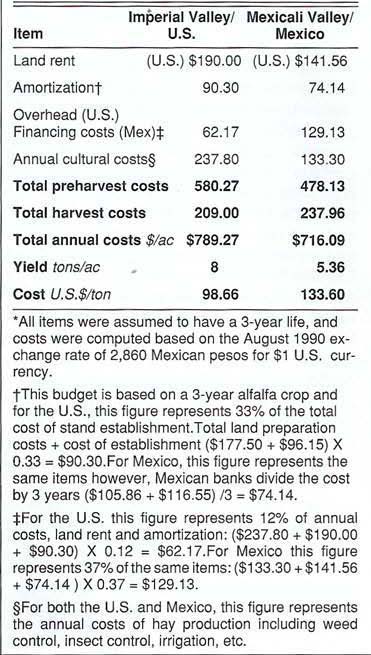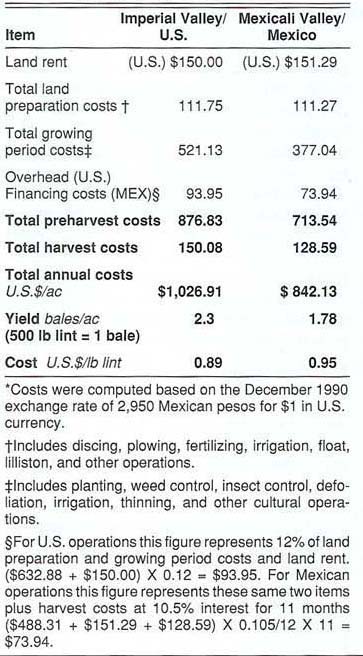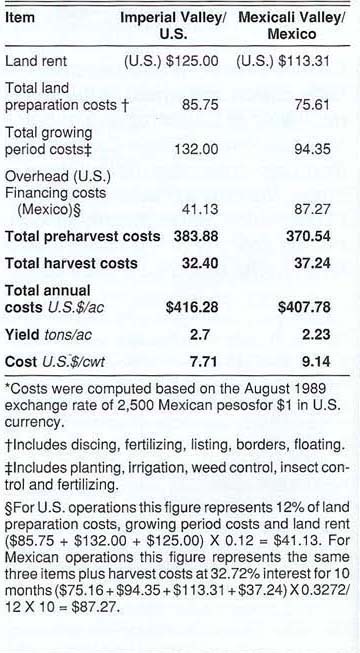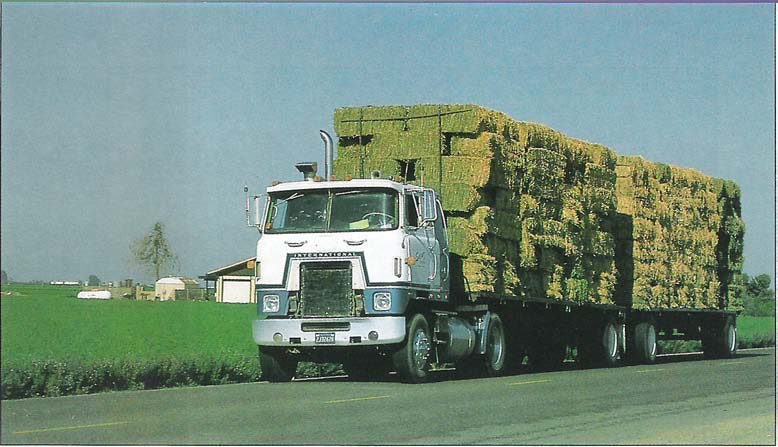All Issues
U.S.-Mexico production costs compared: Imperial Valley holds advantage in alfalfa, wheat and cotton
Publication Information
California Agriculture 45(5):15-17.
Published September 01, 1991
PDF | Citation | Permissions
Abstract
Comparative crop budgets of alfalfa, cotton and wheat in the Imperial Valley of California and in the Mexican Valley of Baja California-North are presented. For all three crops, the cost per acre was higher in the United States than in Mexico but the cost per unit produced was lower In the U.S. than in Mexico.
Full text
Flood-irrigated cotton near Mexicali (above left). Wheat harvesting near Corcoran in the San Joaquin Valley (above).
Mexico President Carlos Salinas de Gortari and United States President George Bush have agreed to enter into negotiations regarding a free trade agreement (FTA) between the two countries. From the perspective of U.S. agriculture along the U.S.-Mexico border, the negotiating teams require information on costs of production for specific crops. This would also be of significant value to producers and local governments. What will be the costs and benefits of the FTA to those that farm along the border?
In addition to information relative to the value of agricultural imports and exports for the United States and Mexico, the negotiating teams can make excellent use of detailed easy-to-read crop production cost data. The extremely difficult task of harmonizing the agricultural tariffs and trade policies makes it increasingly important to develop a format for comparing crop production costs along the U.S. Mexico border. The format must be of sufficient complexity and usefulness to depict the economic advantage of agricultural producers in each country. We felt that a crop budget format with common line items to compare U.S. and Mexican crop production costs would meet that charge.
Methodology
The budget format used allowed crop production data to be presented in the same way for both U.S. and Mexico farmers. In the Imperial Valley of California, crop budget information is available in the UC-Imperial County publication 104F, Guidelines to Production Costs and Practices — Field Crops. This publication has long been used by farmers and financial institutions in the Imperial Valley as they prepare their farm plans and seek financing for their operations. The publication has been the basis of information on which lawsuits have been settled in the Imperial County Courts. It is also used by farmers and banks in the Mexicali Valley as a guide as they prepare their farm plans, because no similar information, in publication form, is available to them. Because it is already in wide use, we selected this particular UC crop budget format. It has endured the test of time and of the courts, and we felt that it offered a safe level of reliability. In the Mexicali Valley valid production cost information comes from a financial institution named Fondo de Garantía y Fomento Para La Agricultura, Ganadería, y Avicultura y Fideicomisos Agricolas (FIRA). FIRA guarantees loans made by banks to farmers. It keeps detailed computerized records on production costs for specific crops, made available to them by individual producers.
It is not the intent of this study to evaluate different crop budget formats currently in use, nor to evaluate crop budgeting methodologies. Rather, its purpose is to compare crop production costs using a crop budget format that is commonly applied along the California-Baja California border, regardless of possible methodological shortcomings.
Tables 1, 2, and 3 depict the production costs and per-unit costs, in summary form, for alfalfa (Medicago sativa L.), cotton (Gossypium hirsutum), and wheat (Triticum aestivum L.) in the Imperial Valley, California and in the Mexicali Valley, Baja California-North, Mexico. The complete crop budget may contain approximately 30 line-items.
A workgroup including one representative from the University of California Cooperative Extension, one representative from FTRA and one representative from the State Department of Agriculture, Baja California-North, assumed the responsibility for comparing crop budgets for the Imperial Valley and for the Mexicali Valley conforming to the format in publication 104F. The individuals serving on the workgroup were knowledgeable with regard to the farming practices and costs of their respective agricultural communities.
Since producers manage their resources differently, line-item costs for a given crop vary across fields and farmers. In the Imperial Valley custom work is often considered because farmers take into consideration the costs of buying and mamtaining expensive equipment used only on a limited basis, labor costs associated with extra staff to operate and care for the equipment, the costs of insuring the equipment and the added responsibility for training, safety, and workers' compensation insurance. For reasons also associated with scale and cost, most Mexican farmers will custom contract many of the required cultural operations. Some farmers may have no machinery at all and will contract custom operators for all field work. Therefore, to insure usefulness, the study requires a simplifying assumption that the cost data be based on custom rates. This allows for easier comparisons between individual sets of production costs.
The cost figures that were used were based on the most recent currency exchange rates relative to the time the specific crop budgets were developed. For example, FIRA may currently be using crop budgets developed in February 1990. Production rates had to be converted from metric to avoirdupois weights and land areas converted from hectares to acres. Economic concepts used in Mexico, such as the daily wage rate for eight hours of labor, had to be included. Mexican agronomic practices had to be clarified in order to fit cost figures provided by FIRA into appropriate line items within the crop budget format.
The workgroup structure minimizes the propensity by individuals to make errors in conversion or to oversimplify a given concept due to the lack of knowledge of each other's farming practices. Each nation has particular agronomic methods, farm accounting procedures and governmental programs specific to the country. Great efforts were made to include only agronomic and economic practices common to both countries, and to include practices that were directly related to the agronomics of a particular commodity. Agronomic practices, farm accounting procedures or governmental programs specific to only one country were excluded from the crop budgets. For example, U.S. budgets exclude subsoil tile system maintenance costs, workers' compensation insurance and commodity association assessments. We made the assumption that U.S. farmers shifting part of their operations to Mexico will not invest in major infrastructure land improvements such as subsoil tile systems, concrete canals, and so on. Mexican farmers shifting operations to the U.S. will in all probability farm land with the above described infrastructure.
On the Mexican budgets, mandated planting permits, social security program costs and crop insurance charges were excluded. Each agronomic or economic cost was carefully scrutinized prior to inclusion in the crop budget and made to conform to the standardized format. Once completed the crop budget comparisons may be used to compare production costs on a per-acre and per-unit basis. Farmers along the border will be primarily interested in the costs of agronomic practices. New operations on either side of the border will make extensive use of custom contractors, if in fact farmers decide to shift part of their operations to the country with the apparent comparative advantage. Specific agronomic practices will be developed by those farmers as they become familiar with the new lands they farm and with the customs and laws of the country.
TABLE 1. Alfalfa crop budgets in the Imperial Valley of California and the Mexicali Valley of Baja California-North, Mexico*
TABLE 2. Cotton crop budgets in the Imperial Valley of California and the Mexicali Valley of Baja California-North, Mexico*
TABLE 3. Wheat crop budgets in the Imperial Valley of California and the Mexicali Valley of Baja California-North, Mexico*
Results
Alfalfa
The production cost per ton of alfalfa in the Imperial Valley is $34.94 less than that of the Mexicali Valley, $98.66 and $133.60 respectively, based on an 8 ton per acre (t/ac) yield in the Imperial Valley and a 5.36 t/ac yield in the Mexicali Valley. The per-acre cost of growing alfalfa in the Imperial Valley in California is $73.18 greater than the per-acre cost of growing alfalfa in the Mexicali Valley of Baja California-North, Mexico (table 1). Total per-acre alfalfa production costs in the Imperial Valley and in the Mexicali Valley are $789.27 and $716.09, respectively. However, harvest costs are greater in the Mexicali Valley. In the Mexicali Valley FIRA finances the harvest costs. Consequently, the associated factors of higher finance charges, a higher interest rate, and lower hay yields make the break-even price higher in the Mexicali Valley.
Cotton
The production cost per pound of lint cotton in the Imperial Valley is $0.06 less than that in the Mexicali Valley — $0.89 and $0.95 respectively, based on 2.3 bales per acre yield in the Imperial Valley and on 1.78 bales per acre yield in the Mexicali Valley. The cost of growing cotton in the Imperial Valley in California is $184.78 greater than that in the Mexicali Valley of Baja CaUfornia-North, Mexico (table 2). Total per-acre cotton production costs in the Imperial Valley and in the Mexicali Valley are $1,026.91 and $842.13 respectively. Preharvest and harvest costs are greater in the Imperial Valley than in the Mexicali Valley.
Wheat
The production cost per hundredweight (cwt) in the Imperial Valley is $1.43/cwt less than that of the Mexicali Valley — $7.71 and $9.14 respectively, based on 2.7 t/ac yield in the Imperial Valley and 2.23 t/ac yield in the Mexicali Valley. The cost of growing wheat in the Imperial Valley in California is $8.50 more than the per-acre cost of growing wheat in the Mexicali Valley of Baja California-North, Mexico — the total per-acre wheat production costs in the Imperial Valley and in the Mexicali Valley are $416.28 and $407.78, respectively (table 3). Total preharvest costs are greater in the Imperial Valley, while harvest costs are greater in the Mexicali Valley.
Discussion
We believe that farmers who decide to farm in their neighboring country will rent and not buy land during the first years of operation. It may very well be that given Mexico's land reform laws, U.S. farmers may not wish to attempt to buy land in Mexico, but will seek to rent land with the improvements they require for the particular crop they wish to farm. Given all the variables that impact a farmer's decision to shift production to another country, the most useful method to present crop budget information is through the use of custom rates.
The three budgets presented show that U.S. farmers have the comparative advantage over Mexican farmers — in spite of the fact that in each case, costs per acre are less in Mexico. The advantage of lower costs per acre in Mexico is cancelled out by the lower yields, this resulting in a higher cost per unit for the Mexican farmer, for the three crops that were compared.
The crop budgets presented in this study are in three field crops. Field crops require extensive use of machines. With the exception of cotton, that is harvested mainly by hand labor in Mexico, the harvest is done with machines. It may be that vegetable crops requiring intensive labor might favor the Mexican farmers, we cannot be certain until we do a similar crop budgeting study for specific vegetables.
In the three crop budgets presented, yields in Mexico are lower than in the U.S. In the future if Mexico were to redirect resources into applied research and set up mechanisms to build up infrastructures such as concrete canal systems and subsoil tile systems to reduce salt buildup, their yields may be improved and their cost per unit could then compare more favorably with the U.S. farmer's cost per unit.
Should Mexico's inflation rate continue to decline, as it has in the past 5 years, the stability of its currency may also have a positive impact on the Mexican farmer's ability to lower his or her cost per unit.
Conclusion
This study is meant to provide information to help farmers decide if they want to shift production to their neighboring country, assuming that country has the apparent comparative advantage. Other factors such as changes in social legislation affecting labor costs and changes in interest rates affecting financing will vary over time and farmers have no control over those costs. The crop budget format used in this study to compare the costs of producing specific crops along the U.S. Mexico border can be an extremely useful tool for those persons selected to serve on the teams negotiating a U.S.-Mexico free trade agreement (FTA). This crop budget study uses a common line-item format to compare U.S. and Mexican crop per-acre production costs and per-unit production costs.
The information provided by this study may also be utilized by local governments such as county boards of supervisors and city councils to project potential impacts of the FTA on their constituents, should the production of any given commodity shift totally or in part, into or out of their jurisdiction.
Crop budget comparisons are also needed for cauliflower, tomatoes, strawberries, grapes, citrus, avocados, and cut flowers. (Related articles in this issue describe budget comparisons for asparagus, broccoli and livestock production.)









